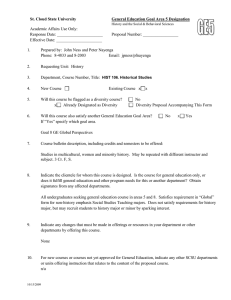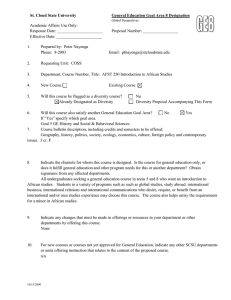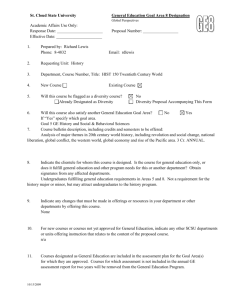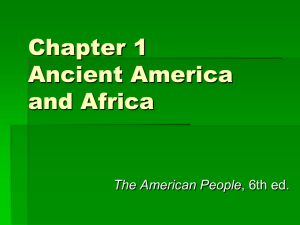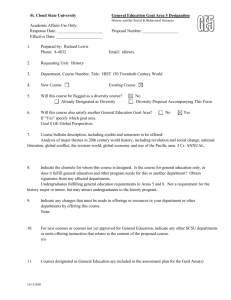GE-10-8. HIST 106 Historical Studies
advertisement
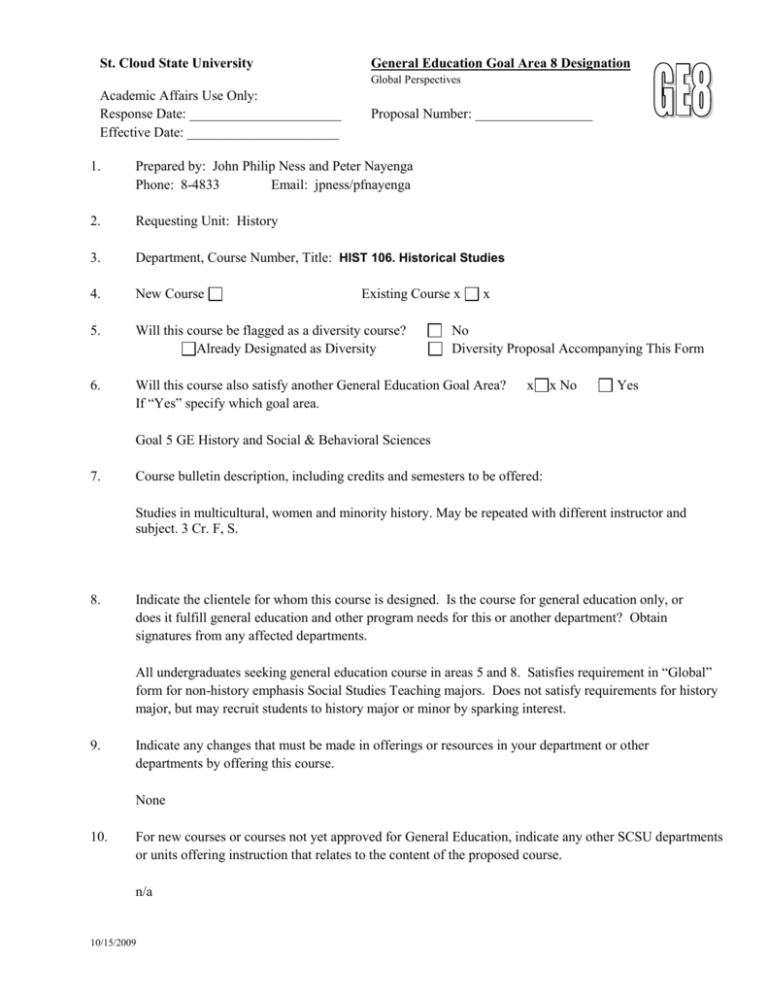
St. Cloud State University General Education Goal Area 8 Designation Global Perspectives Academic Affairs Use Only: Response Date: ______________________ Effective Date: ______________________ Proposal Number: _________________ 1. Prepared by: John Philip Ness and Peter Nayenga Phone: 8-4833 Email: jpness/pfnayenga 2. Requesting Unit: History 3. Department, Course Number, Title: HIST 106. Historical Studies 4. New Course 5. Will this course be flagged as a diversity course? Already Designated as Diversity 6. Will this course also satisfy another General Education Goal Area? If “Yes” specify which goal area. Existing Course x x No Diversity Proposal Accompanying This Form x x No Yes Goal 5 GE History and Social & Behavioral Sciences 7. Course bulletin description, including credits and semesters to be offered: Studies in multicultural, women and minority history. May be repeated with different instructor and subject. 3 Cr. F, S. 8. Indicate the clientele for whom this course is designed. Is the course for general education only, or does it fulfill general education and other program needs for this or another department? Obtain signatures from any affected departments. All undergraduates seeking general education course in areas 5 and 8. Satisfies requirement in “Global” form for non-history emphasis Social Studies Teaching majors. Does not satisfy requirements for history major, but may recruit students to history major or minor by sparking interest. 9. Indicate any changes that must be made in offerings or resources in your department or other departments by offering this course. None 10. For new courses or courses not yet approved for General Education, indicate any other SCSU departments or units offering instruction that relates to the content of the proposed course. n/a 10/15/2009 11. Courses designated as General Education are included in the assessment plan for the Goal Area(s) for which they are approved. Courses for which assessment is not included in the annual GE assessment report for two years will be removed from the General Education Program. The Requesting Unit understands and recognizes the above conditions. 12. Provide a concise explanation of how the following goal is a “significant focus” of the proposed course. Goal Area 8: Global Perspectives Develop a comparative perspective and understanding of one’s place in a global context. Through the examination of topics in “historical studies” from around the globe, students will acquire a familiarity with major events and figures as studied via different human societies and behaviors. The student will also develop skills in critical reading of both primary and secondary sources, in research, in the comprehension of textual and lecture material, in class discussion, and in the composition of essays. 13. In order for a course to be designated as fulfilling Goal Area 8, it must address at least 4 of the 5 student learning outcomes (SLOs) below. Check the SLOs below that are focused on in the proposed general education course. X 1. Explain how they are connected and related to people elsewhere in the world. X 2. Describe similarities and differences among global places and populations. X 3. Analyze how political, economic or cultural elements influence relations among the world’s states, peoples, or societies. X 4. Analyze specific international issues and propose and evaluate responses. 5. Articulate a vision of their individual roles and responsibilities in a common global future. 14. Discuss how each Student Learning Outcome checked above is achieved in this course. (Note: Although descriptions of typical assignments or types of assignments may be part of this discussion, it is not appropriate to submit copies of actual assignments.) Students are required through written and oral course work, i.e., instructor generated examination questions, student generated theses (papers), and student oral presentations to: 1) analyze the social, political and cultural reasons for the global migration of peoples and their cultures both in the past and continuing into the present. Students will access this information by analyzing case studies including personal accounts of the people themselves in English translation. 2) describe the differences and similarities of the demographic and geographic profiles of various global areas. Students will demonstrate this ability by charting maps and graphs as well as utilizing data as evidence to corroborate their findings. 10/15/2009 3) analyze how political, economic or cultural elements influence relations among the world’s states, peoples, or societies. Students will demonstrate this ability by addressing issues such as religious differences, disputes over land and water rights, trade disagreements, and linguistic and racial differences. 4) analyze specific international issues and propose and evaluate responses. Students will demonstrate this by analyzing such issues as nuclear proliferation in NE Asia and Southwest Asia, North-South wealth imbalances, conflicts in the Sudan, Central Africa, Afghanistan, Iraq and Palestine, and questions of nation-building in Africa. 15. List or attach the Course Outline (adequately described and including percentage of time to be allocated to each topic). Curriculum Committees may request additional information. Topics larger than 20% need to be broken down further. Indicate in your course outline where the Student Learning Outcomes checked above are being met. Course outline 1.: An investigation of the different revolutionary responses of China and Japan to the modern world. Both societies changed dramatically, China through chaos and revolution, Japan through assimilation of foreign ideas. I. Introduction 20% A. Revolution and Modernization B. Geography of China and Japan II. Traditional China, 1644-1911 20% A. Traditional China B. Rebellion, Restoration, Reform, Reaction C. Revolution of 1911 D. Intellectual Revolution III. Nationalist China, 1911-1945 20% A. Warlordism B. Kuomintang, 1918-1937 C. Chinese Communist Party, 1921-1937 D. Chinese-Japanese War, 1937-1945 E. Yenan Communism, 1937-1945 IV. People’s Republic of China, 1945 to Present 20% A. Revolution, 1945-1949 B. Consolidation and Revolutionary Change, 1949-1965. C. Cultural Revolution, 1965-1969. D. Contemporary China, 1969 to Present. V. Japan, 1850 to Present 20% A. Meiji Japan B. Taisho Period C. Militarism, Authoritarianism and War Course outline 2: The nature and role of cities in Classical Greece, Renaissance Italy and Medieval Japan, against the background of broader historical developments. The course focuses on political systems, society and economics, religion, culture and the physical appearance of cities. I. Introduction—Theories of Cities 15% II. Classical Greece 35% (breakdown below) A. Politics 10% B. Society and Economics 5% C. Archaic Poetry 5% D. Religion and Philosophy 5% 10/15/2009 E. Athens 5% F. Other Greek Cities 5% III. Mediterranean and Medieval Cities A. Hellenistic Cities 5% B. Roman Cities 10% C. Medieval Cities 10% IV. Renaissance Italy A. Politics 5% B. Society and Economics 5% C. Religion 5% D. Aristocratic Cities 5% E. Castle Towns 5% I. 25% (breakdown below) 25% (breakdown below) Course outline 3: Introduction: Using novels as “texts,” the course aims at two objectives: to equip students with an historical analysis of the socio-economic and political problems facing contemporary Africa and to make a critical evaluation of the solutions applied to them. Given the size of the continent, a thematic approach is used. Myths and Realities About Africa. An examination of the misconceptions normally contained in newspapers and books about African peoples. 10% II. The Struggle for Independence. A study of European Colonialism and the subsequent rise of African nationalism. 20% III. Identifying Problems of Nation Building. Inexperienced leadership, manpower shortage. Economic dependence, ethnicity, and regionalism. 20% IV. Solutions to Problems of Nation Building. The experimentation in multiparty systems; the one-party state; military intervention in politics; economic “open-door” policies, African socialism, Afro-Arab socialism and the “Marxist” experimentation. 20% V. Towards Continental Unity. Through Organization of African Unity (OAU), African leaders have approached continental problems by trying to bring about closer economic and political unity and the liberation of the non-independent parts of the continent. 10% VI. Current Events. To keep abreast with the ever-changing political situation in Africa, there are weekly discussions of current events on the continent. 20% 10/15/2009
